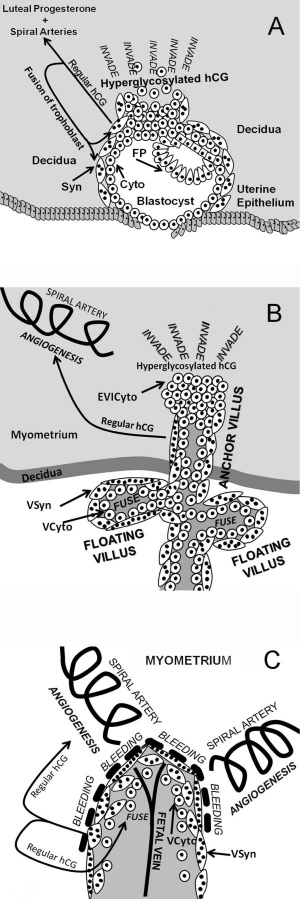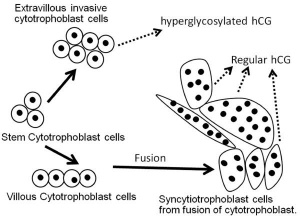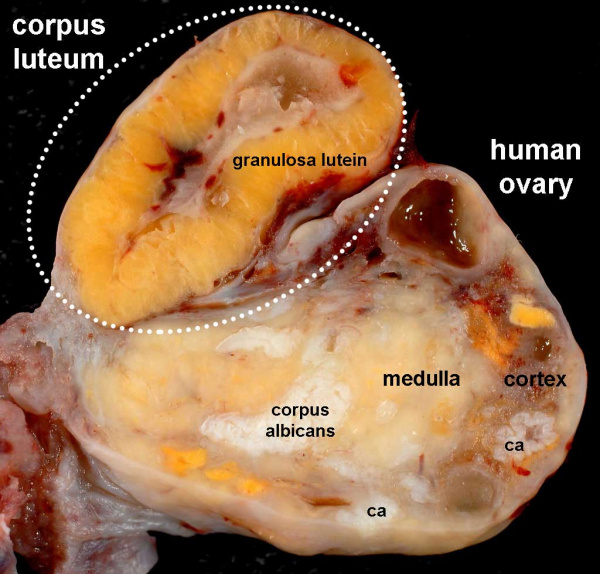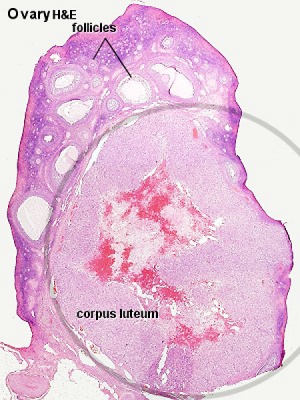Human Chorionic Gonadotropin
| Embryology - 27 Apr 2024 |
|---|
| Google Translate - select your language from the list shown below (this will open a new external page) |
|
العربية | català | 中文 | 中國傳統的 | français | Deutsche | עִברִית | हिंदी | bahasa Indonesia | italiano | 日本語 | 한국어 | မြန်မာ | Pilipino | Polskie | português | ਪੰਜਾਬੀ ਦੇ | Română | русский | Español | Swahili | Svensk | ไทย | Türkçe | اردو | ייִדיש | Tiếng Việt These external translations are automated and may not be accurate. (More? About Translations) |
Introduction
Human chorionic gonadotropin (hCG, or human chorionic gonadotrophin) is a placental hormone initially secreted by cells (syncitiotrophoblasts) from the implanting conceptus during week 2, supporting the ovarian corpus luteum, which in turn supports the endometrial lining and therefore maintains pregnancy.[1][2]
The hormone can be detected in maternal blood and urine and is the basis of many pregnancy tests. The protein has many other roles including stimulating the onset of fetal gonadal steroidogenesis, and high levels have been found to be a teratogen to the fetal gonadal tissues.
Other potential cellular sources can include: hyperglycosylated hCG produced by cytotrophoblast cells, free beta-subunit made by multiple primary non-trophoblastic malignancies, and pituitary hCG made by the gonadotrope cells of the anterior pituitary.
A member of the glycoprotein hormone family that includes the pituitary hormones: luteinizing hormone (LH), follicle-stimulating hormone (FSH), and thyroid-stimulating hormone (TSH).
|
| Factor Links: AMH | hCG | BMP | sonic hedgehog | bHLH | HOX | FGF | FOX | Hippo | LIM | Nanog | NGF | Nodal | Notch | PAX | retinoic acid | SIX | Slit2/Robo1 | SOX | TBX | TGF-beta | VEGF | WNT | Category:Molecular |
Some Recent Findings
|
| More recent papers |
|---|
|
This table allows an automated computer search of the external PubMed database using the listed "Search term" text link.
More? References | Discussion Page | Journal Searches | 2019 References | 2020 References Search term: Human Chorionic Gonadotropin <pubmed limit=5>Human Chorionic Gonadotropin</pubmed> |
Functions
- Promotion of corpus luteal progesterone production
- Angiogenesis of uterine vasculature
- Cytotrophoblast differentiation
- Immuno-suppression and blockage of phagocytosis of invading trophoblast cells
- Growth of uterus in line with fetal growth
- Quiescence of uterine muscle contraction
- Promotion of growth and differentiation of fetal organs
- Umbilical cord growth and development
- Blastocysts signals endometrium prior to implantation
- hCG in sperm and receptors found in fallopian tubes suggesting pre-pregnancy communication
- hCG receptors in adult brain hippocampus, hypothalamus and brain stem, may cause pregnancy nausea and vomiting
- hCG and implantation of pregnancy, hCG stimulates metalloproteinases of cytotrophoblast cell
Function Data from Table 1[2]
Maternal Blood Levels
| Pregnancy | |
|---|---|
| Time (GA) weeks | Levels (mIU/mL) |
| 0 - 1 weeks | 0 - 50 |
| 1 - 2 weeks | 40 - 300 |
| 3 - 4 weeks | 500 - 6,000 |
| 1 - 2 months | 5,000 - 200,000 |
| 2 - 3 months | 10,000-100,000 |
| second trimester | 3,000 - 50,000 |
| third trimester | 1,000 - 50,000 |
| Non-pregnant | < 5.0 |
| Post-menopausal | < 9.5 |
| Pregnancy test - greater than 20 mIU/mL (milli-international units per milliliter) is a positive result. Levels peak at 8 to 10 weeks of pregnancy, then decline and are lower for rest of pregnancy. | |
Protein
Human 5 protein forms:
- hCG
- sulfated hCG
- hyperglycosylated hCG
- hCG free beta
- hyperglycosylated free beta
The molecular weight of hCG is approximately 36,000 (36 KDa) for the α-subunit and a β-subunit that are held together by both non-covalent hydrophobic and ionic interactions.
Corpus Luteum
Section through the middle of a human ovary at mid-luteal phase of the menstrual cycle after ovulation. (unlabeled image).
- corpus luteum (white ring) shown at top left of ovary. Note the size and colour of the the corpus luteum ("yellow body") compared to the ovary and other internal structures. If implantation and pregnancy occurs, then hCG would stimulate an increase in size and hormonal function during the early pregnancy.
- white asterisks - possible older corpora lutea remnants.
- corpus albicans (white arrow) shown at the bottom right of the ovary. Note the size and colour of the corpus albicans ("white body") compared to the corpus luteum and ovary. The corpus albicans is the degenerating non-functional form of the corpus luteum that "develops" from it if implantation and pregnancy do not occur.
- black asterisks - possible older corpora albicantia remnants.
Black arrows show the approximate cortex and medullary regions of the ovary.
Ovary corpus luteum histology.
Genital Development
Placental secreted hCG has leutenizing hiormone-like effects that can effect genital development, stimulating testosterone production from the testes of the male fetus and subsequent development of male genital system.
References
- ↑ Cole LA. (2012). hCG, the wonder of today's science. Reprod. Biol. Endocrinol. , 10, 24. PMID: 22455390 DOI.
- ↑ 2.0 2.1 Cole LA. (2010). Biological functions of hCG and hCG-related molecules. Reprod. Biol. Endocrinol. , 8, 102. PMID: 20735820 DOI.
- ↑ Yamaguchi M, Ohba T, Tashiro H, Yamada G & Katabuchi H. (2013). Human chorionic gonadotropin induces human macrophages to form intracytoplasmic vacuoles mimicking Hofbauer cells in human chorionic villi. Cells Tissues Organs (Print) , 197, 127-35. PMID: 23128164 DOI.
- ↑ Kim JH, Shin MS, Yi G, Jee BC, Lee JR, Suh CS & Kim SH. (2012). Serum biomarkers for predicting pregnancy outcome in women undergoing IVF: human chorionic gonadotropin, progesterone, and inhibin A level at 11 days post-ET. Clin Exp Reprod Med , 39, 28-32. PMID: 22563548 DOI.
Search Pubmed
Search Pubmed: Human Chorionic Gonadotropin | hCG
Search Bookshelf: Human Chorionic Gonadotropin
Search OMIM: Human Chorionic Gonadotropin
External Links
External Links Notice - The dynamic nature of the internet may mean that some of these listed links may no longer function. If the link no longer works search the web with the link text or name. Links to any external commercial sites are provided for information purposes only and should never be considered an endorsement. UNSW Embryology is provided as an educational resource with no clinical information or commercial affiliation.
Glossary Links
- Glossary: A | B | C | D | E | F | G | H | I | J | K | L | M | N | O | P | Q | R | S | T | U | V | W | X | Y | Z | Numbers | Symbols | Term Link
Cite this page: Hill, M.A. (2024, April 27) Embryology Human Chorionic Gonadotropin. Retrieved from https://embryology.med.unsw.edu.au/embryology/index.php/Human_Chorionic_Gonadotropin
- © Dr Mark Hill 2024, UNSW Embryology ISBN: 978 0 7334 2609 4 - UNSW CRICOS Provider Code No. 00098G





